
|

Saturday, July 17 to Sunday, August 22, 2004
Wednesday, September 1 to Wednesday, December 15, 2004 |
| |
Organized by MIHO MUSEUM, Kyoto
Shimbun Co., Ltd. |
|
Sponsored by the Embassy of Ecuador
in Japan, Embassy of Guatemala, Embassy of Costa Rica, Embassy of the
Republic of Peru in Japan, Embassy of Mexico in Japan, Shiga Prefecture,
Shiga Prefectural Board of Education, NHK (Japan Broadcasting
Corporation) Otsu. |
|
THE
EARLY CIVILIZATIONS OF THE EURASIAN CONTINENT have left an amazing cultural
legacy. Their peoples were materially and culturally connected and
influenced one another. While the ancient cultures of the so-called “New
World,” the Americas, was unique in world history in that it developed
independently without exchange with other civilizations. This civilization
built great pyramids and magnificent palaces equal to Egypt and developed an
accurate astronomical system and calendar. Without knowledge of iron, the
wheel, rice, or wheat, they created a sophisticated civilization with
Neolithic innovations and based on a stable of maize.
|

|
|
|
Mesoamerica encompasses the cultural sphere
developed by the various peoples from the north of central Mexico,
extending southwards to Guatemala, Belize, Honduras, including a part of
Ecuador. Though the different groups used different languages, they
shared common agricultural techniques, crops, calendar, religions, and
ceremonies.
|
|
Olmecs The Jungle People that Found the Oldest Mesoamerican Civilization
|
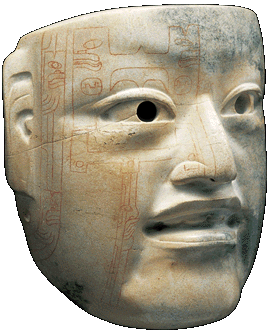
Olmec Jade Mask 900-600 B.C.

This great mask carved from a large piece of jade and expresses youthful
features. During ceremonies, a king wore this mask, which may have unified
him through the lines incised upon its surface with the power to preside
over the universe. |
Olmec Stone Ax 900-600 B.C.

The Olmecs saw green-colored, jade-like stones as the ear of maize and made ritual axes in the shape of corn. Axes were used in fields and demarcated the sacred realm of the maize field, where the symbol of cosmic life, the tree of life, grew.
 |
Teotihuacans
The Highlanders who Built the Largest Mesoamerican Settlement on a Sacred Land
|
Teotihuacan Jade Mask
A.D. 200-650

This mask with its realistic features is highly stylized and distinctive from the Olmec mask. The deep green stone represents the life energy of the universe, while the earrings of light green stone was borrowed from the Mayan artifacts. |
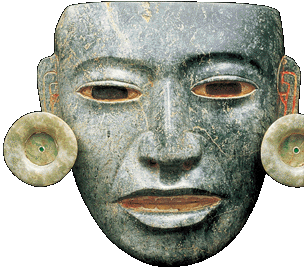 |
The Mayan
A Jungle People that Developed an Accurate Calendar and Almost Unlocked the Mysteries of the Universe
|
Mayan Jade Pendant c. 452 A.D.

This pendant has a hieroglyphic inscription of a ritual that took place at the end of a king’s rule. Several of these pendants were tied together at the waist and worn for many generations as part of a king's formal attire.
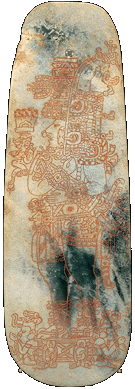
Mayan Earthen Vessel A.D. 400-500

This three-legged vessel is incised with scenes of a paradise of an afterworld filled with music and blossoming flowers. The inscription indicates that a king drank a special cocoa out of this cup.
|
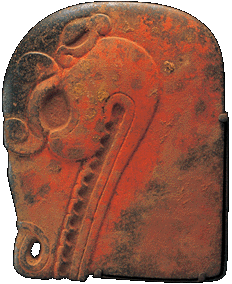 Mayan Stone Protective Gear
Mayan Stone Protective Gear
A.D. 600-900

Mesoamerican ballgames were sacred rituals that started from the time of the Olmecs and symbolized battles in which life was sacrificed to the gods. Heavy gear such as this, carved with a powerful creature, was worn to protect the athletes from the rubber ball used in the game.
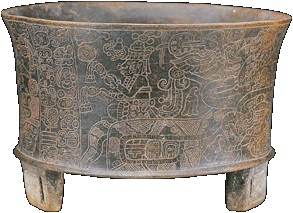 |






